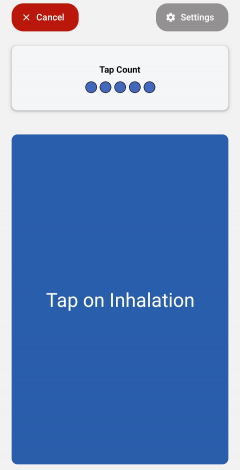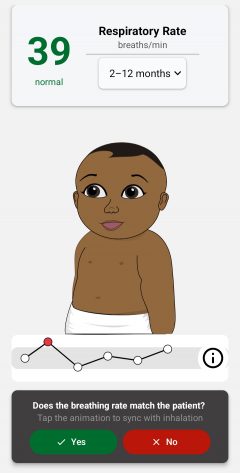Respiratory rate (RR) is a fundamental measurement for disease diagnosis, prognosis, and treatment in children. Unfortunately, many studies have demonstrated that clinically obtained measures can be inaccurate in a variety of health-care settings. We have developed and validated a mobile phone application for the efficient and accurate measurement of respiratory rate. The RRate app is available for Android and iOS, and can also be used directly in a browser at rrate.netlify.app.


Detecting Fast Breathing
One of the keys to detecting pneumonia in children, is the measurement of Respiratory Rate, specifically determining if a child has fast breathing. The World Health Organization's (WHO) Integrated Management of Childhood Illness guidelines identify fast breathing as 50 breaths per minute or more in children aged 2 months to 12 months and 40 breaths per minute or more in children aged 12 months up to 5 years. As seen above, the RRate app can display whether the respiratory rate is normal or high once you enter an age category for the child.
The WHO promotes measuring RR by counting the number of breaths in a minute. There are many limitations to this method. It is time consuming and requires full attention. If any disruption to the counting occurs, the minute must be restarted. The RRate application is meant to solve this problem by providing a mobile application that can accurately calculate the respiratory rate in less than 10 seconds.
Detecting Consistent Taps
The RRate app displays the RR value as soon as enough consistently timed taps have been performed. Two parameters control this consistency check, as shown on the Configuration settings page of the application. This is only accessibly with a password, since the app defaults to the settings recommended by our research studies.
The first parameter, z, is the number of taps used in the RR calculation. If z = 4, then the RR is calculated based on the median of the 3 time intervals between the most recent 4 taps. This means you must tap at least 4 times, and if the 4 taps are not consistent enough, then you keep tapping and each time you tap the consistency is checked again using the timing of the most recent 4 taps. In the app, z is set to 5 by default.
The second parameter, C, is the consistency threshold necessary for the time intervals between the most recent z taps. The consistency zone is defined as the median of these intervals plus and minus C% of this median. For example, if the median time interval = 2.0 seconds and C = 10%, the time intervals must all be in the range of 1.8 - 2.2 seconds. If they are in this range the application shows a breathing baby with animation and sound/vibration for confirmation of the RR. If one or more of the time intervals is not in this range, the user must keep tapping. In the app, C is set to 13% by default.

Publications
See our publications behind all the research done to choose the app default settings and test the app's accuracy, efficiency, and repeatability in a real-world setting.
A Asdo, A Mawji, I Omara, IA Aye Ishebukara, C Komugisha, SK Novakowski, Y Pillay, MO Wiens, S Akech, F Oyella, A Tagoola, N Kissoon, JM Ansermino, D Dunsmuir. (2025) Repeatability of RRate measurements in children during triage in two Ugandan hospitals. PLOS Glob Public Health 5(1): e0003097. doi.org/10.1371/journal.pgph.0003097
Society for Technology in Anesthesia 2014 Annual Meeting abstract which won the Best Clinical Application award:
A Asdo, A Mawji, I Omara, C Agaba, C Komugisha, S Novakowski, Y Pillay, M Wiens, S Akech, F Oyella, A Tagoola, N Kissoon, JM Ansermino, D Dunsmuir. Repeatability of Respiratory Rate Measurements in Children during Triage in Two Ugandan Hospitals. Anesthesia & Analgesia 138(4S):p 1-104, April 2024. doi.org/10.1213/01.ane.0001011528.18574.c2
H Gan, W Karlen, D Dunsmuir, G Zhou, M Chiu, GA Dumont, JM Ansermino (2015) The Performance of a Mobile Phone Respiratory Rate Counter Compared to the WHO ARI Timer. J Healthc Eng, 6(4), 691-703. doi.org/10.1260/2040-2295.6.4.691
W Karlen, H Gan, M Chiu, D Dunsmuir, G Zhou, GA Dumont, & JM Ansermino (2014). Improving the Accuracy and Efficiency of Respiratory Rate Measurements in Children Using Mobile Devices. PLoS ONE, 9(6), e99266. doi.org/10.1371/journal.pone.0099266
Society for Technology in Anesthesia 2014 Annual Meeting abstract:
The Design of a Respiratory Rate Mobile Application
Code and Configuration
The RRate app code is available on a public GitHub repository for anyone to see and the Wiki on the GitHub repository explains how to configure it to upload to REDCap or for use with another application using the SMART on FHIR protocol.